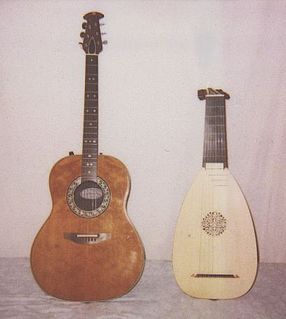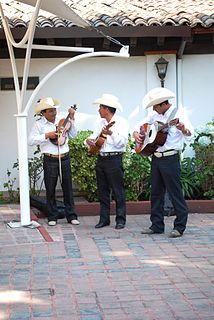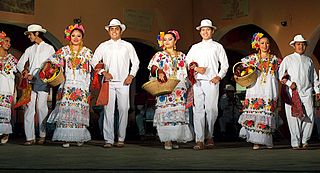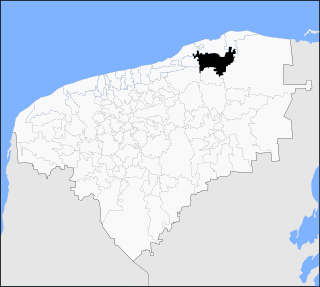
The güiro is a Latin American percussion instrument consisting of an open-ended, hollow gourd with parallel notches cut in one side. It is played by rubbing a stick or tines along the notches to produce a ratchet sound.

San Francisco de Campeche, 19th c. English also Campeachy, is a city in Campeche Municipality in the state of Campeche, Mexico on the shore of the Bay of Campeche of the Gulf of Mexico. Both the seat of the municipality and the state's capital, the city had a population at the 2010 census of 220,389, and the municipality had a population of 259,005.

Bajo sexto is a Mexican string instrument from the guitar family with 12 strings in six double courses. A closely related instrument is the bajo quinto which has 10 strings in five double courses.

The jarana jarocha is a guitar-shaped fretted stringed instrument from the southern region of the state of Veracruz, Mexico. Typically strung with 8 strings in 5 courses, usually arranged in two single outer strings with three double-courses in between. The strings are usually nylon, although they were gut in the past. The body is somewhat narrower than a guitar because of its direct lineage from the Spanish baroque guitar of the sixteenth century. Sometimes mistaken for a ukulele, the jarana jarocha comes in at least five sizes, the smallest being the chaquiste, somewhat smaller than a soprano ukulele; then the mosquito, about the size of a soprano ukulele; the 'primera', about the size of a concert ukulele; the 'segunda', in length between a tenor and a baritone ukulele; and the 'tercera', somewhat longer than the baritone ukulele. Some luthiers are building jaranas of a size they label "tercerola" or "jarana cuarta", but there is some discussion as to whether these represent a distinct size or are merely particularly large variations of the standard tercera.

Regional styles of Mexican music vary greatly vary from state to state. Norteño, banda, duranguense, Mexican Son music and other Mexican country music genres are often known as regional Mexican music because each state produces different musical sounds and lyrics.

Plucked string instruments are a subcategory of string instruments that are played by plucking the strings. Plucking is a way of pulling and releasing the string in such a way as to give it an impulse that causes the string to vibrate. Plucking can be done with either a finger or a plectrum.

Son huasteco is one of eight Mexican song styles and is a traditional Mexican musical style originating in the six state area of Northeastern Mexico called La Huasteca. It dates back to the end of the 19th century and is influenced by Spanish and indigenous cultures. Usually it is played by a Trio Huasteco composed of a guitarra quinta huapanguera a Jarana huasteca and a violin. Singers will often use the falsetto register. The son huasteco is particularly noteworthy for its flamboyant and virtuoso violin parts, although the style varies from state to state. Footwork often danced to son huasteco is the Zapateado. Improvisation plays a strong role in the style, with musicians creating their own lyrics and arrangements to a standard repertoire. Typical sones huastecos are "Cielito lindo", "La huazanga", "La sirena", "El querreque" and "La cigarra".

The music of the ancient Mayan courts is described through native and Spanish 16th-century texts and is depicted in the art of the Classic Period. The Maya played instruments such as trumpets, flutes, whistles, and drums, and used music to accompany funerals, celebrations, and other rituals. Although no written music has survived, archaeologists have excavated musical instruments and painted and carved depictions of the ancient Maya that show how music was a complex element of societal and religious structure. Most of the music itself disappeared after the dissolution of the Maya courts following the Spanish Conquest. Some Mayan music has prevailed, however, and has been fused with Spanish influences.

The huapanguera, guitarra quinta huapanguera or guitarra huapanguera is a Mexican guitar-like instrument that usually forms part of a conjunto huasteco ensemble, along with the jarana huasteca guitar and violin. Because of its large body and deeper structure, the huapanguera is able provide a much deeper sound compared to a regular acoustic guitar. Here it takes on the role of the bass instrument using a rhythmical strumming technique. Its physical construction features a large resonating body with a short neck. It normally has 8 to 10 frets which stop at the point where the fingerboard meets the top.

Teabo Municipality is one of the 106 subdivisions of the State of Yucatán in Mexico. Its municipal seat is located in the town of Teabo.

The jarana is the typical dance and musical form of the Yucatan Peninsula. There exists two forms of metrics in jarana: "6 por 8" and "3 por 4". The jarana dance is done in pairs that consists of footwork without distinguished steps nor differentiation between women and men. The jarana is performed by a winds band ensemble.

Dzidzantún is a town in Mexico in the northeastern Yucatan, which serves as the headquarters of the municipio or administrative unit of the Dzidzantún Municipality.

The jarana huasteca, jarana de son huasteco or jaranita is a string instrument. It is most often called simply jarana.
The arpa jarocha is a large wooden harp that is normally played while standing, although early examples from the 16th through the first three or four decades of the 19th centuries were smaller and were played while seated. It has a wooden frame, a resonator, a flat soundboard, 32-36 nylon strings, and does not have pedals. This harp is tuned diatonically over five octaves. The top of its soundboard sometimes arches outward due to the tension of the strings. Unlike other Mexican harps, the arpa jarocha has its sound holes located on the back of the sound board instead of on the front.

Panabá Municipality is one of the 106 municipalities in the state of Yucatán, Mexico. It is located in the eastern region of the Yucatán Peninsula's northern coast. Panabá is also the name of the municipality's largest township, which is also its municipal seat. The municipality is bounded at the north by the municipalities of San Felipe and Rio Lagartos, at the east by Tizimín, at the south by Sucilá and at the west by the municipalities of Dzilam de Bravo and Dzilam González.

Javier Álvarez Fuentes is a Mexican composer who is known for creating works that combine a variety of international musical styles and traditions that often utilize unusual instruments and new music technologies. According to composer John Adams, "The music of Javier Alvarez reveals influences of popular cultures that go beyond the borders of our own time and place." Álvarez is one of the best-known Mexican composers of his generation and many of the works in his prolific oeuvre combine music technology with diverse instruments and influences from around the world.

The rondalla is an ensemble of stringed instruments played with the plectrum or pick and generally known as plectrum instruments. It originated in Medieval Spain, especially in the ancient Crown of Aragon: Catalonia, Aragon, Murcia, and Valencia. The tradition was later taken to Spanish America and the Philippines. The word rondalla is from the Spanish ronda, meaning "serenade."

Son mexicano is a category of Mexican folk music and dance that encompasses various regional genres, all of which are called son. The term son literally means "sound" in Spanish, and is also applied to other unrelated genres, most notably son cubano.
Son Armado is a Mexican-American cultural organization dedicated to the proliferation of the Son Jarocho Fandango, an education-based art form that revolves around celebrations and community gatherings known as Fandangos. Son Armado is based in Austin, Texas.














